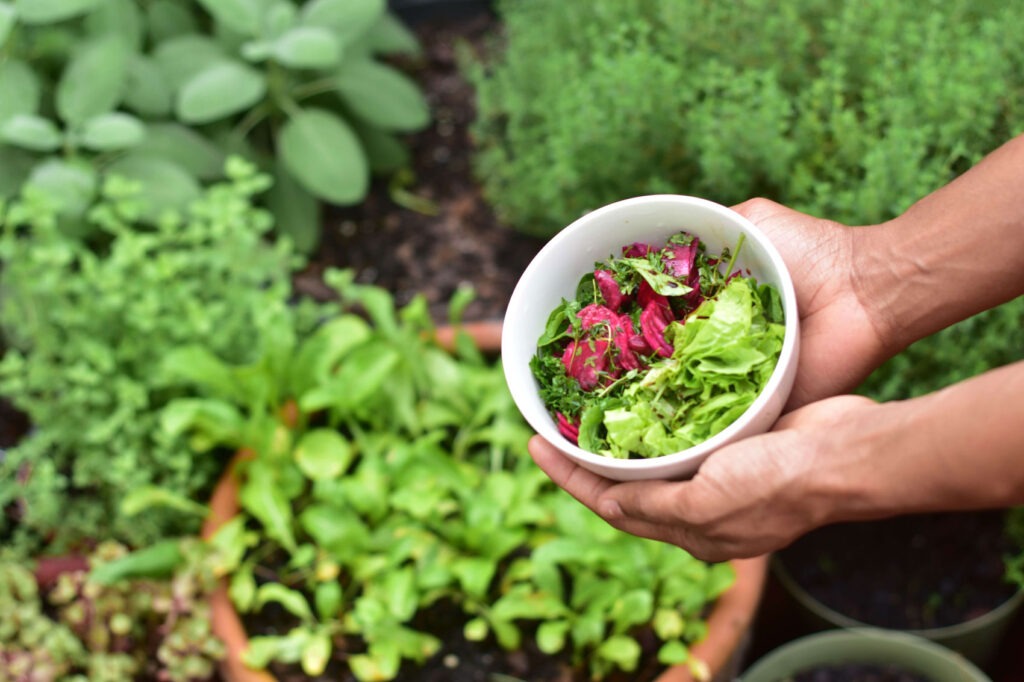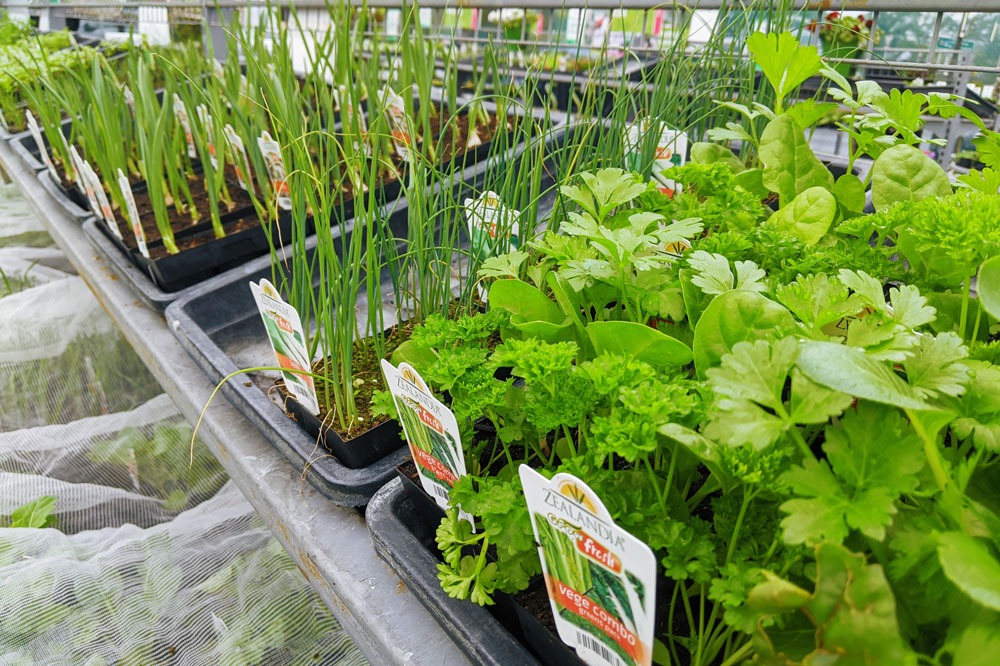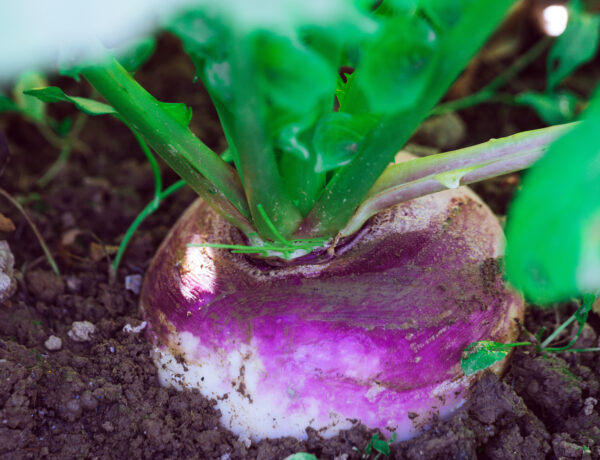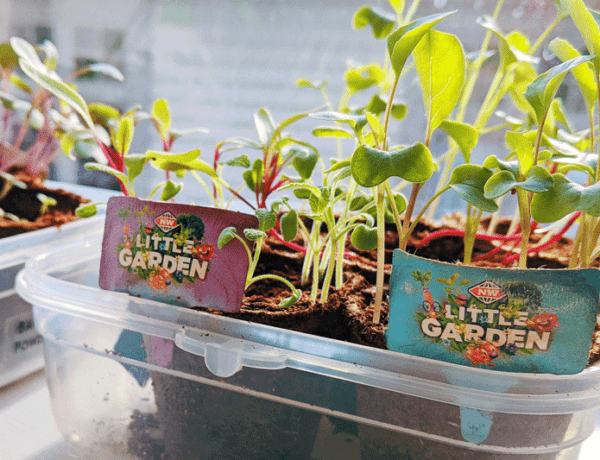Have you always wanted to try your hand at vegetable gardening but don’t know where to begin? Well, you’re in the right place. This article is going to cover everything a beginner gardener needs to know about how to start a vegetable garden from scratch.
If you’ve never successfully grown a living thing in your life, or it’s been a while since you last wielded a trowel, then growing vegetables might seem a bit daunting to start with but I promise you it isn’t. I’m going to explain each step in detail so that you understand it’s importance, and I promise to leave out all the technical jargon (or what I call ‘gardenise’) that can often leave new gardeners feeling overwhelmed.
This article contains affiliate / compensated links. For full information, please see our disclaimer here.
Let’s start at the very beginning…
How Does Your Garden Grow?
If you’re going to learn how to start a vegetable garden and grow vegetables, then it makes sense to understand what it is that makes them grow. So bear with me.
Cast your mind back to high school biology…you’ll remember there are three essential ingredients that plants need to grow:
- Sunlight
- Water
- Food
That’s it. Simple? Well if you keep this ‘perfect trifecta’ in mind when it comes to the decisions you make for your vegetable garden, then growing vegetables doesn’t need to be complicated!
How to Start a Vegetable Garden for Beginners
My philosophy when it comes to gardening is start somewhere! Whether you’re growing in an apartment or on a lifestyle block, there’s always somewhere and some way to grow edibles.
In an apartment situation, you may have room on a balcony for a few pots or even an indoor garden when considering how to start a vegetable garden. Or if you have a backyard, then a potager garden or raised vegetable garden bed is a great way to grow vegetables.
Anyone Can Grow Their Own Food
I smile when I think back to my university days… my friend and I used to joke about how she’d never been able to successfully grow a vegetable in her life. So before she left for Wellington I bought her a ‘Garden in a Box’.
This was essentially a 1m x 0.5m styrofoam box with a bag of potting mix and seed packets inside. Her apartment was on the third storey with a fire escape so, with great intentions of proving she could grow vegetables, she planted her little garden outside.
Alas! Within a month her poor little garden had become the resident’s ashtray – her little seeds never stood a chance! In her defence, a couple of years later in a (private!) ground storey flat, she proved she did know how to start a vegetable garden by raising 30 tomato plants one summer! Needless to say, she got creative with finding recipes and uses for tomatoes!
The point of my story is that anyone can grow vegetables (perhaps just check that your fire escape isn’t the communal smoking hang out first), whether it’s growing herbs in pots inside, a potager kitchen garden or a large garden plot.
So with this in mind, let’s start this edible journey together. Ready? Let’s go!

6 Steps for How to Start a Vegetable Garden at Home
1) Choose a Location
First things first, where you choose to plant your vegetable garden is very important. Think back to our ‘perfect trifecta’ – sunlight is a biggy for plants (without dredging up old memories of science class, plants use light to create energy through the process of photosynthesis).
So when choosing a spot for your garden or pots, consider where gets the most sun (minimum 6hrs is ideal). In saying this, if you only have shade to work with don’t despair, there are some plants that grow well in shade such as leafy greens, lettuce and kale.
“Leaves are like solar panels. You want to make sure they are in an optimal position to draw as much sunlight as possible.”
Different Types of Vegetable Gardens
You’ll also want to consider the type of garden you can create based on the space you have available. Here are a few options to consider:
Raised Vegetable Beds or Potager Gardens
These are a popular option. They allow control over the soil you plant in and can reduce weeds by placing a weed barrier in the bottom.
Depending on the height and construction material of your raised bed, this can be a relatively inexpensive way of creating a garden that allows you the versatility to grow various vegetable plants and tend them without too much strain on your body.
Pots or Containers
A great solution when space is limited. Herbs and plant varieties such as growing strawberries work really well in pots.
The beauty of a container is they can be moved to optimise sunlight in different seasons, or can be taken with you should you have to move house.
Vegetable Garden Plots
A garden plot or planting directly in the soil is what our ancestors would have done and is another practical option when considering how to start a vegetable garden.
This can be done by skimming off the top layer of the ground to remove grass and weeds, then digging and turning over the soil. It is important to note when choosing this method that you’ll still need to add compost to the soil; native soil alone will be lacking adequate nutrition.
The “No Dig” Method
It is worth a quick mention here about the “No Dig” method, also known as “no-till” gardening, as this method is growing in popularity.
The aim is to leave the soil undisturbed in order to preserve and nurture the natural soil structure. This encourages the growth of beneficial microorganisms and earthworms, leading to healthier soil and better drainage and aeration.
To implement the “No Dig” method in your garden, start by layering thick cardboard over the area you wish to have your garden, and add a thick layer (around 3-4 inches) of organic materials such as compost, well-rotted manure, shredded leaves and straw on the cardboard.
Next, apply a generous layer of organic mulch like wood chips, straw and dried leaves on top of the soil mix.
Make small holes in the top layer of mulch to plant your seeds or transplanted seedlings directly into the soil in the bottom layer.
Throughout the growing season, replenish the mulch as needed to maintain its thickness and effectiveness at suppressing weeds.
By following these simple steps, you can enjoy a healthy, thriving garden with less effort and intervention.
Gardening Tip: A well-tended, small garden is better than a large untended one, so when you’re just starting, consider how much time you have to dedicate to watering and weeding your garden and create a garden accordingly.
2) Soil, Soil, Soil
Soil deserves a heading all of its own because I cannot stress how important it is if you want to grow a successful vegetable garden. You might consider soil an unnecessary expense but food in our ‘trifecta’ is an essential ingredient to success!
Time and again I have come across people who have said they are no good at gardening; then when I look at where they’ve planted their plants, they’re in nothing more than dirt.
Think about raising a child. If you want them to grow strong and healthy, you wouldn’t feed them a diet of only junk food and treats, would you? Of course not, you would (try!) to feed them a balanced diet of fruit, veggies, protein, carbohydrates etc.
The same principle is applied to growing vegetables. Plant them in soil with no nutrients and they will fail to thrive. Plant them in a beautiful rich soil full of good food and they will reward you.
What Soil do I Need to Grow Vegetables?
To start I would recommend potting mix or native soil (i.e. garden soil from your garden) mixed with compost (organic matter, broken down food scraps, leaves, bark etc). If you don’t have a compost bin, your local garden centre will have a selection of done-for-you bag mixes.
I review my top compost picks in my article the Best Compost to Buy for Vegetable Gardening.
A great starting point is 50/50 compost to potting mix (or even 1/3 to 2/3 at a pinch). So for raised gardens, you could add equal bags of potting mix to compost. Alternatively, if you have native soil from your garden, use this to fill up half your raised bed, then dig through 50% compost. For garden plots, dig compost straight into the existing soil or layer on top for the “no dig” method.
For large garden plots or potagers, consider going to a landscape supply shop. There you can purchase soil by the trailer load for a lot less than the cost of bags.
Garden Tip: It’s a good idea to prepare your soil 2-3 weeks before planting seedlings to allow time for the soil to settle and absorb the nutrients
If you think your soil isn’t looking to rich or has struggled to grow anything in the past, then you could look at having a soil test done. This will tell you exactly what nutrients the soil is lacking. However, when you’re just starting out, all you need to begin is a good base of compost and soil.
Good soil is attractive to worms which in turn fertilise your plants (through worm castings aka worm poo). So you want to entice these bad boys to come and stay as much as possible! Good soil = good tenants (aka worms) = good crop of vegetables, so it’s worth investing in the ‘groundwork’.
3) Seedlings or Seeds

When you’re just starting out, my recommendation is to choose seedling over seeds. Although seedlings are more expensive, their success rate is higher and you’re going to yield results a lot faster.
If you’re growing vegetables on a budget, garden centers always have regular sales so keep an eye out for specials. I also like to try my luck in what I call the ‘plant rescue section’ where packs are only $1 or $2 so I don’t have a lot to lose if they don’t survive (and if they do I feel a small sense of an achievement that my little seedlings have achieved their purpose in life!)
Further down the track once you have gained some confidence, growing seeds is a great way to go. I must admit there’s always a moment of elation when the first tiny seed heads poke out of the soil!
Garden Tip: To give your seedlings an added boost, I always soak my seedling trays in an organic seaweed solution before planting them in the ground. This makes a huge difference and gives them a great start to life in their new home.
It’s important to remember that you need to add to your soil regularly, unfortunately, it’s never a case of once you’ve put in good soil that’s the last time you have to do it.
As plants grow, they draw all those beautiful nutrients from the soil to produce a crop. So every season before you plant a new crop, it’s important to dig through some fresh compost to give your soil a boost ready to feed the next lot of hungry plants.
Also be mindful of planting in the right season. Even though the garden centers might sell them, there’s no point growing winter crops in summer as they simply won’t grow! Take a look at gardening guides for advice such as this one on what to plant in autumn /fall.
Crop Rotation
The other thing to consider from one season to the next is rotating your crops (aka trying not to plant the same vegetables in the same position in your garden each year). The reason for this is because different plants draw and deposit different nutrients into the soil.
Some plants such as tomatoes, broccoli and lettuce are heavy feeders, meaning they draw lots of nutrients from the soil. While others like potatoes, garlic and onions are light feeders.
Rotating crops regularly in your vegetable gardens is a great way to make the best use of nutrients in your soil.
In saying all this. If you just have a small space to grow, for now, don’t worry too much about this principle, instead concentrate on adding compost or nutrients to your plants before, partway through the growing cycle and after harvest to boost nutrition.
4) How to Plant Vegetables
When to Plant
A common mistake that new gardeners make is planting in the wrong season. I can recommend several books that contain excellent guides which I refer back to year after year. Step-by-step Veg Patch in particular is my go-to, with comprehensive growing guides for almost every vegetable.
Alternatively, you can find a great garden planner or vegetable growing guide online. Just be sure to search for a link to one written for your country and growing season. You don’t want to find yourself planting according to the seasons in the opposite hemisphere!
Plan
Once you have chosen your plants, it’s time to get them in the ground! The first thing to do is consider your vegetable garden layout.
When you purchase seeds or seedlings there’s usually a guide on the back of the packet/tag indicating the optimal amount of sunlight or shade, and the distance needed between each seedling.
It may look like too much space, to begin with, but trust me they’ll grow in no time and you don’t want overcrowding (or what I call a ‘plant mosh pit’) where your plants have to compete for sunlight and nutrients.
I have accidentally done this in the past and it results in some runty plants and some leader plants which still weren’t as lush as they should’ve been.
Remember the solar panel concept I talked about? Bare this in mind when choosing where to plant and how much space to give each seedling.

Vegetable Companion Planting
It’s worth keeping in mind here the concept of vegetable companion planting.
This is a gardening approach that involves strategically planting certain herbs and vegetables together to enhance growth, deter pests, and improve soil health.
By pairing compatible plants together (e.g. basil and tomatoes), you can take advantage of a plant’s natural ability to repel pests, provide shade, fix nitrogen in soil or optimize space.
This age-old practice has so many natural benefits for the garden! It creates a sustainable garden ecosystem, promoting healthier plants and higher yields without the need for chemical interventions.
Planting
If you choose to pre-soak your seedlings in Organic Seaweed Mix before planting, then do this now while you map out your plot.
Mix up the solution in a bucket, place the whole seedling (pot and all) into the bucket so the pot is submerged. Once bubbles start to appear, remove and continue with the next pot.
Once you have a rough idea of where each plant is going, use a trowel to dig a small hole then carefully tip and remove the seedling from its pot (if it has been soaking be careful as the soil can fall apart easily).
You want to protect the roots as much as possible so keep the soil intact around the roots of the plant as you carefully place it in the hole.
Still holding the plant, carefully fill in the space around it with soil then firmly pressing the soil around the stalk of the plant so it can stand upright on its own it. You want the seeding to be reasonably level with the ground once planted. If it’s too low then it can become waterlogged and rot the stem, too high and the roots may be exposed to the elements and dry out.
Mulch
Weed domination is the top reason why people give up on their garden. It’s a good idea to spread a thick layer of mulch over the soil from the start to help minimise this. By laying mulch over the soil you’re blocking sunlight from reaching any weed seeds, thereby preventing them from germinating (growing).
Mulch is also great for water retention in the garden. Particularly important if you experience hot summers!
You will want a good few centimetres worth of mulch across your garden bed. There are several different types of organic matter you could use for mulch but I would suggest either straw (not hay as it may contain weed seeds) or shredded leaves or wood chip.
Spread the mulch evenly to cover any exposed soil, but leave a few centimetres around the stem of each plant so that as it decomposes it doesn’t rot the plant.
Talk to Others
I find it invaluable talking with other gardeners; I find it especially helpful talking to the great staff at my local garden center as I always like to ask for advice when it comes to selecting the best variety of vegetables.
How to grow vegetables is a topic people are eager to talk about and offer advice on – much of it tried and true. So if you’re ever stuck, don’t be afraid to reach out!
In the same breath, if you need some advice on how to start a vegetable garden, feel free to drop me a comment below and I’d be more than happy to help.
5) Plan to Water Regularly
To give your seedlings a good start, at the beginning it’s important to water them at least every day for the first few days. After this, you can reduce the amount of water you give them to every 2-3 days; (depending on how hot the weather is). This will encourage the plant’s roots to grow deeper as they look for water.
Aim to water early in the morning or in the evening to avoid the heat of the day. This will reduce the risk of sunburn from water reflecting off leaves.
It might go without saying but make sure you have easy access to a tap to water your garden. It’s a good idea to invest in a good hose or watering can in your collection of essential gardening tools.

6) How to Take Care of your New Vegetable Garden
Now that you know how to start a vegetable garden and it’s all set up; there are a few things I suggest you do regularly to ensure you keep on top of it:
- Pull out weeds while they are young and easy to pluck. Whatever you do you don’t want weeds to go to ‘seed’ as they will disperse little seed babies all over your garden!
- Stake plants as required. Vegetables like tomatoes and beans need the support of stakes; it helps to have these at the ready as they grow.
- Harvest regularly (at least once a week). By leaving produce on the plant for too long the plant will think it’s done its job and stop producing as fervently!
- Fertilise your garden soil regularly to help plants thrive. Every 2-4 weeks I’d recommend mixing up a watering can of Seaweed Mix. Watering your vegetables by hand will give them that extra boost. This is especially important for heavy feeders like tomatoes and cabbages. Giving all your plants a little extra love though won’t go a miss.
Then that’s it; how to start a vegetable garden in 6 steps!
The key to gardening is that there is always something new to learn – it’s always a case of trial and error. So never give up! Even the most experienced gardeners learn something new each season.
It’s always great to experiment! For example, one thing I’d love to try is sprouting wheat. You can unlock so many nutritional benefits from this useful grain by sprouting and milling it yourself.
What are you most looking forward to growing in your vegetable garden?
Final Words on How to Start a Vegetable Garden
You now have a detailed plan for how to successfully plant your first vegetable garden; you’re well on your way to growing your own edibles! I’d love to see and celebrate your garden creations if you’d share them with me on The Potager Project Facebook page.
There are so many healthy, nutritious recipes you can make with the fresh vegetables you’ve grown in your garden. I look forward to sharing some of my favourites in later posts.
I’m so proud of you for taking this first step and learning how to start a vegetable garden (I realise for some of you, it’s way out of your comfort zone!) Trust me, when you start harvesting your vegetables and tasting the difference, you’ll be so pleased you did!

About the Author
Elle Reed is a passionate gardener and advocate for teaching beginner gardeners how to grow their own food. Elle’s mission is to inspire and empower people to get back to basics, grow their own produce, and embrace a sustainable lifestyle. “Whether it’s a few herb pots in an apartment, a potager or a full garden plot, we can all ‘start somewhere’ to grow our own food, and in doing so, provide healthier food for ourselves and those we love”.





